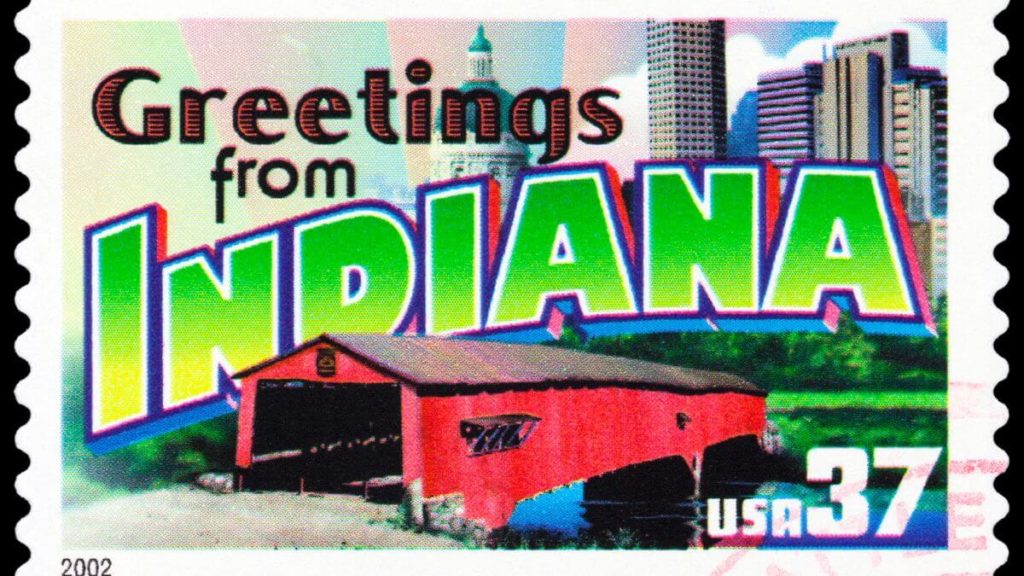
Living or visiting Indiana and wondering what bird you’re looking at? This article covers common birds of Indiana. Odds are high the bird you’re looking at is one of them. It will also inform you on how to identify them.
Birding in Indiana
There are some exceptional opportunities for birding in Indiana. With miles of shoreline around Lake Michigan, plenty of wetland, the Indiana Dunes States Park, and Hoosier National Forest, there are always birds to be discovered. The Goose Pond Fish and Wildlife areas have more than 280 species of birds.
An especially popular birding spot is Eagle Creek Park amid urban Indianapolis. More than 270 different species of birds call this city greenery home.
Indiana Dunes State Park is filled with waterfowl and gulls. Wander up the park’s Trail 10 to catch sight of the rare Kirtland’s Warbler and other Warbler species, the Scarlet Tanager, and the beautiful Baltimore Orioles. The best place to spot them is away from the crowd at the beach. Ducks, gulls, terns, and loons inhabit the shores of Lake Michigan.
Potato Creek State Park is a combination of forest and grassland surrounding a lake, a popular sighting area for many birds. Ospreys are known to nest by the lake, alongside Wood Ducks, Great Blue Heron, and the Green Heron.
Goose Pond, southwest of Bloomington, is another popular site for birders. The marches attract shorebirds, wading birds, geese, and ducks. Rare birds such as the Spotted Redshank and Curley Sandpiper have also been seen. Cranes may be spotted during the spring months.
Celery Bog is a preserve near Lafayette with more than 250 different types of birds.
Most Common Birds of Indiana
Great Egret
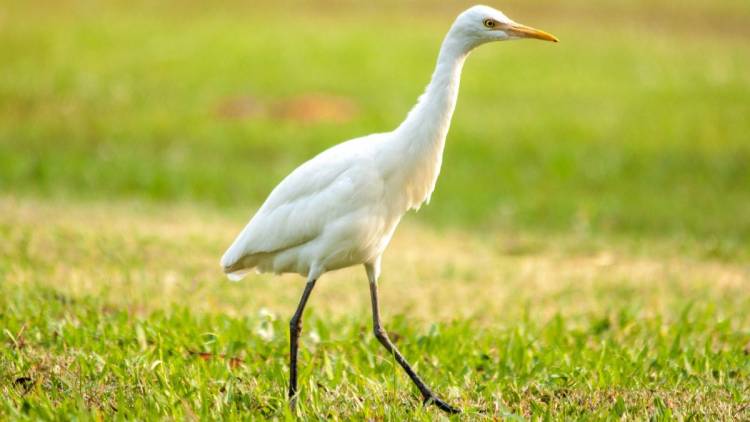
The Great Egret can be found on the shore of Lake Michigan. Their presence in Indiana has increased in the counties of Greene, Porter, and Vigo. They are snowy white with yellowish bills and a long neck and long black legs. They grow from 37.0 to 40.9 inches in length and weigh 35.3 ounces with a wingspan of 51.6 to 57.1.
They move in shallow water to feed on fish and frogs. They can use their long bills to snap up food quickly.
Sandhill Crane
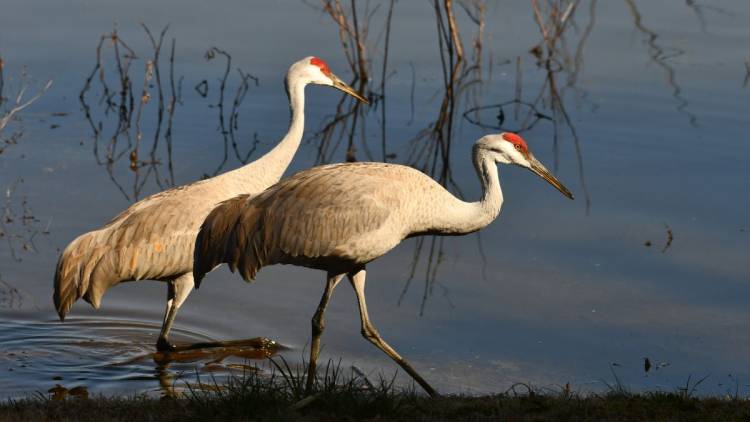
The Sandhill Crane in Indiana can be spotted at the Jasper-Pulaski Fish & Wildlife Area during the fall and early winter months and can best be viewed from the Sandhill Crane Observation Area. Their natural habitat is wetlands, marshes, and river basins.
The Sandhill Cranes grow up to four feet in height with a wingspan exceeding five feet. They are grey with a red crown on their head and white cheeks. From the Observation Area, they flock to local farms to feed on grain and careless mice.
Pileated Woodpecker

The Piliated Woodpecker is Indiana’s largest Woodpecker and lives here all year round. They grow 15.8 to 19.3 inches in length and weigh between 8.8 to 12.3 ounces with a wingspan of 26 to 29.5 inches. They are striking-looking, all in black with a white stripe and a white underside and a bright red crest on their head. The male has a red stripe along his cheek.
They feed on ants, beetle larvae, termites, as well as nuts, and berries. They nest in dead trees and can be spotted in forests that have plenty of dead trees. The Pileated Woodpecker can be lured to a feeder with suet, sunflower seeds, peanuts, and mealworms.
Black-bellied Plover
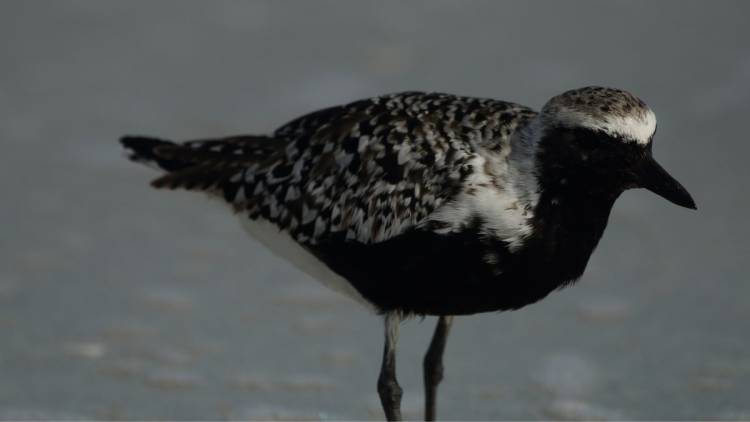
The Black-bellied Plover grows between 11 and 11.4 inches in length and weighs between 6 and 9.7 inches with a wingspan of 23.2 to 23.6 inches. The male has a deep black face and front, with a sharply contrasting white crown, and undertail, and dark legs and bill. The female’s colors are less sharp and contrasting.
They remain mostly near wetlands and the coastline, where they can find mollusks, marine worms, crustaceans, and insects.
Indigo Bunting
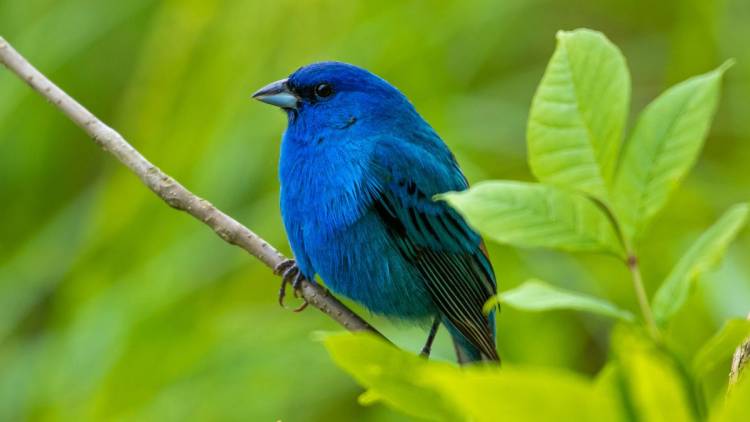
The male Indigo Bunting is almost surreal with his rich blue body and thick silver bill. The female is a dull brown with a white throat and just a hint of blue on the wings, tails, and rump. They are short, plump birds with short tails. They grow between 4.7 to 5.1 in length and weigh between 0.4 to 0.6 ounces with a wingspan of 7.5 to 8.7.
The male spends a lot of time singing from treetops and phone lines, as if he wants to call attention to his dramatic beauty. They feed on seeds, berries, and insects and spend most of their time in brushes and hedgerows where they forage for seeds.
Common Birds of Indiana by Color
Black Birds in Indiana
Red-winged Blackbird

The Red-winged Blackbird is a stocky bird with a medium-sized tail. The male is black with hard-to-miss and impressive red shoulder patches. The female is brownish with whitish eyebrows. The male uses his extraordinary appearance to perch and get noticed by females. They are the player in the blackbird world and will breed with as many as 15 females.
Both male and female grow to a length of 6.7 to 9.1 inches and weigh between 1.1 and 2.7 ounces with a wingspan between 12.2 and 15.8 inches. They live around water, marches, wet roads, and sometimes in dry meadows and fields. Their nests are usually built within moist areas. During the summer, they feed on insects and seeds while adding corn and wheat to their diet during the winter months.
Orchard Oriole

The Orchard Oriole spends April through December in Indiana, and May through August is the best time to look for them. The male has a black head and back with a red underside. The female is a greenish-yellow color with white wing bars and bears little resemblance to the male.
They grow between 5.9 and 7.1 inches in length and weigh between 0.6 and 1.0 ounces with a wingspan of 9.8 inches. They spend time along riverbanks and farms and can be attracted to backyards with orange fruit, such as orange slices, which they apparently love. Their regular diet consists of ants, beetles, spiders, caterpillars, and fruit.
Brewer Blackbird
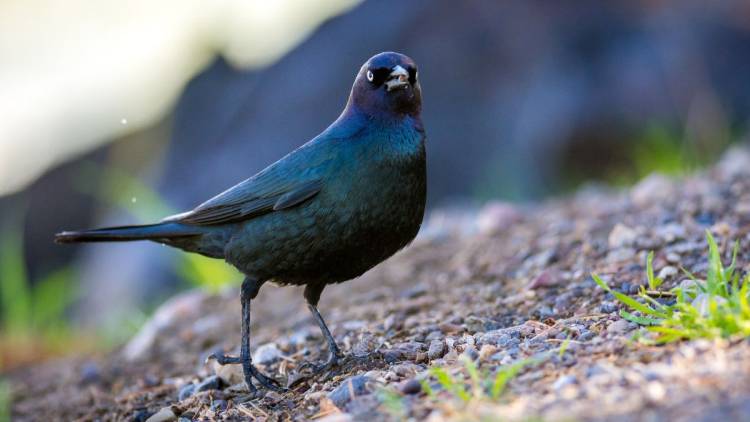
The Brewster Blackbird is a medium-sized bird with a glossy black coat that has some green mixed in and some purple color on the head. The female is plain brown in color. They grow in length from 7.9 to 9.8 inches and weigh between 1.8 and 3.0 ounces with a wingspan of 14.6 inches.
Their habitats include meadows, woodlands, parks, open fields, marshes, and backyards, where they feed on grain and insects. They will come to feeders for sunflower seeds, millet, and cracked corn.
Blue Birds in Indiana
Eastern Bluebird in Indiana

The Eastern Bluebird is small with a plump body. The legs, tail, and bill are short, as well. They grow in length between 6.3 and 8.3 inches and weigh between 1.0 and 1.1 ounces with a wingspan between 9.8 and 12.6 inches. The male is a deep blue with a red throat and breast. The female has more grayish tints and a less vivid breast.
They live in meadows, open fields, and golf courses and perch on wires and low branches. Eastern Bluebirds feed on insects or, during the winter, on berries. They are plentiful in Indiana and can be attracted to a backyard birdfeeder by providing berries and insects.
Blue Jay

The Blue Jay is various shades of white on the breast, with shades of blue and white on the wings. Their tails have black stripes, and there is a black stripe across the throat. Blue Jays grow between 9.8 and 11.8 inches in length and weigh between 2.5 and 3.5 ounces with a wingspan between 13.4 and 16.9 inches.
They live on the edge of forests, parks, and urban areas, and feed on acorns and oaks.
Blue Grosbeak

The Blue Grosbeak is a stocky blue bird with a triangular black and silver beak. Blue Grosbeaks grow between 5.9 and 6.3 inches in length and weigh between 0.9 and 1.1 ounces with a wingspan of 11.0 inches.
The male is blue with a black “Zorro” mask around the eyes. Females are brown with a bluish tail. Both the male and the female have an upper chestnut wingbar and a lower gray wingbar.
They inhabit open fields and breed in grass or shrubs and usually feed on insects and seeds.
Orange Birds in Indiana
Barn Swallow
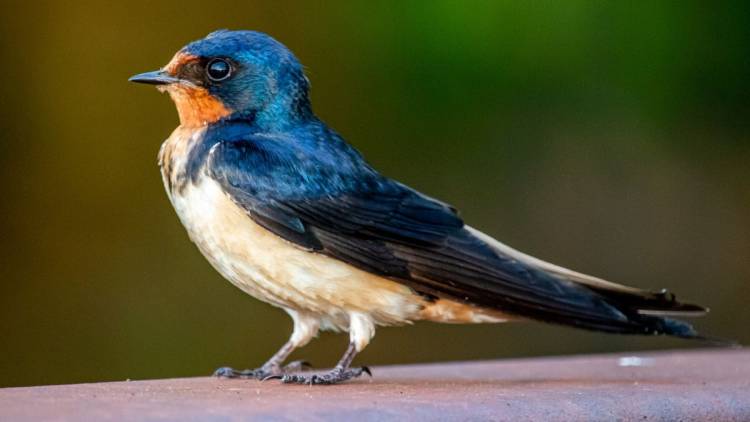
The barn swallow has broad shoulders, short feet, no neck, a head that is somewhat flattered, and long pointy forked wings. They are a bit smaller than the Bluebird. The Barn Swallow grows to 5.9 to 7.5 inches in length and weighs between 0.6 to 0.7 ounces with a wingspan of 11.4 to 12.6 inches. Their back is blue while their underpart and part of their face is tawny orange.
They live in open areas such as fields, parks, meadows, and near waters and feed on insects that they snap up in midair.
Red-breasted Nuthatch

The Red-breasted Nuthatch is blue-gray on top with a black cap and an orange and black stripe over the eye. The underbelly is a rich orange/cinnamon color, which is much paler on the female. Their body is plump, and they have very short tail.
The Red-breasted Nuthatch grows to 4.3 inches in length, and weighs between 0.3 and 0.5 ounces with a wingspan between 7.1 and 7.9 inches. They live in coniferous forests, especially in Indiana, among the firs, pines, and spruce. Sometimes, they can be found in hickory or maple trees. They feed on insects such as ants, beetles, spiders, and flies during the breeding season, and they eat conifer seeds at other times.
American Redstart in Indiana
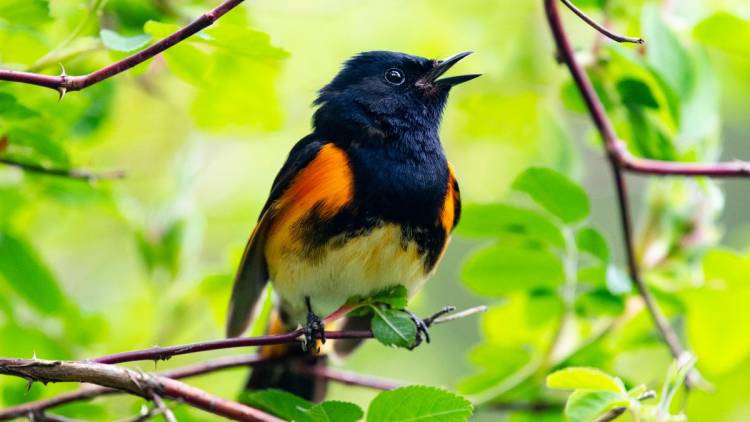
The American Redstart has a black body and head with orange patches on its wings, tail, and sides. The underbelly is white. Females have yellow patches instead of orange ones. They are a wide bird with a flat bill.
Both the male and female grow between 4.3 and 5.1 inches in length, weight between 0.2 and 0.3 ounces with a wingspan between 6.3 and 7.5 inches. They inhabit deciduous trees and hunt insects by flashing their bright tail. If the insect moves, the American Redstart will snap it up. It is the avian version of dining on the fly.
Yellow Birds in Indiana
American Goldfinch

American Goldfinch lives in Indiana year-round. The male is a bright yellow, while the female is a duller shade. The male also turns duller during the winter.
They grow 4.3 to 5.1 inches in length and weigh 0.4 to 0.7 ounces with a wingspan of 7.5 to 8.7 inches. The American Goldfinch lives in fields and weedy areas and feeds on sunflower, aster plants, and thistle. They can also be found in parks and backyards.
Common Yellowthroat
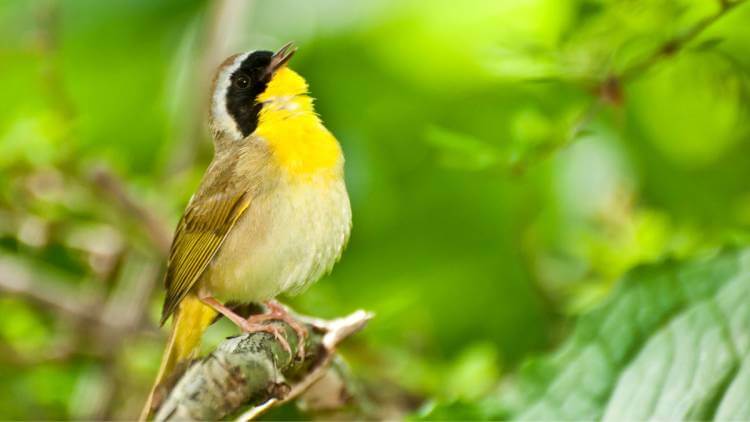
The Common Yellowthroat is a common sight in Indiana between April and October. The male has a bright yellow underbelly with a long tail and a brownish back. His face is covered with a black mask beneath a tuft of which hair. The female is also yellow, but she lacks the mysterious mask.
They grow between 4.3 and 5.1 inches and weigh 0.3 ounces with a wingspan of 5.9 to 7.5 inches. They live in wetlands and fields with thick vegetation where they feed on insects, seeds, and small fruit.
Cedar Waxwing
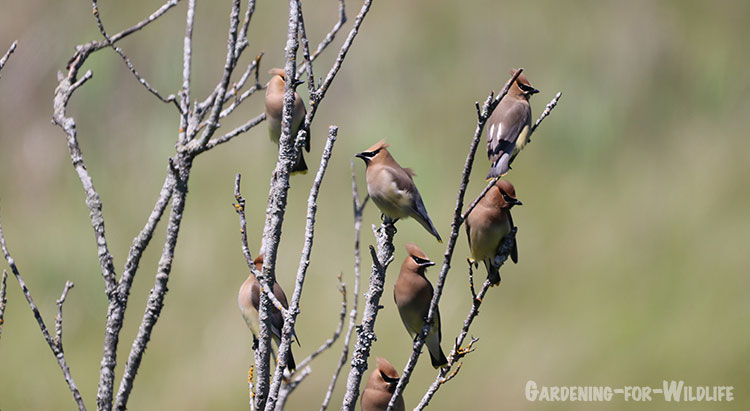
The Cedar Waxwing is a sleek bird with a large head and short, wide bill. They have a rakish backward leaning brown crest on their brown head and a soft yellow belly. Their most distinguishing feature is a black mask with white feather trim, making the Cedar Waxwing look somewhat like a frustrated avian bank robber. The wings have bright red tips reminiscent of short, red fingernails.
Both male and female grow to a length of 5.5 to 6.7 inches and weigh 1.1 ounces with a wingspan of 8.7 to 11.8. They spend their time eating the berries in fruiting trees and are one of the few birds that can survive on just fruits for a long time. They do, however, occasionally add insects to their diet.
Common Birds of Indiana by Species
Warblers in Indiana
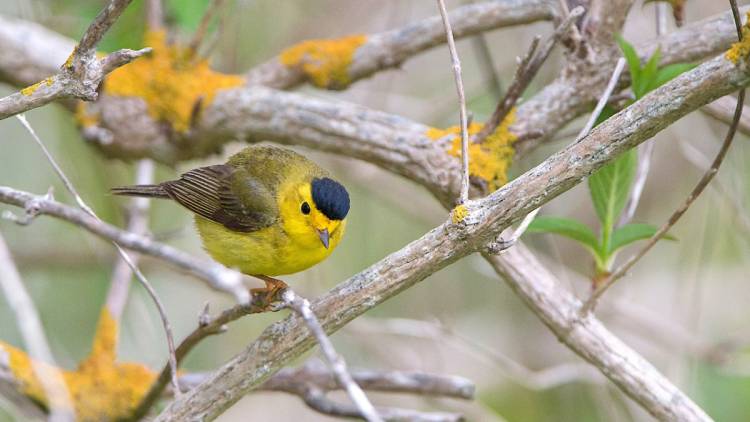
Wilson’s Warbler – Cardellina pusilla – grows to a length of 3.9 to 4.7 inches and weighs 5 to 10 grams. They are yellow breasted with brownish wings and a unique black cap that resembles a toupee. The female’s cap has more of a green hue. They nest low to the ground, such as in shrubs, and feed on insects such as beetles, caterpillars, and even bees and wasps.
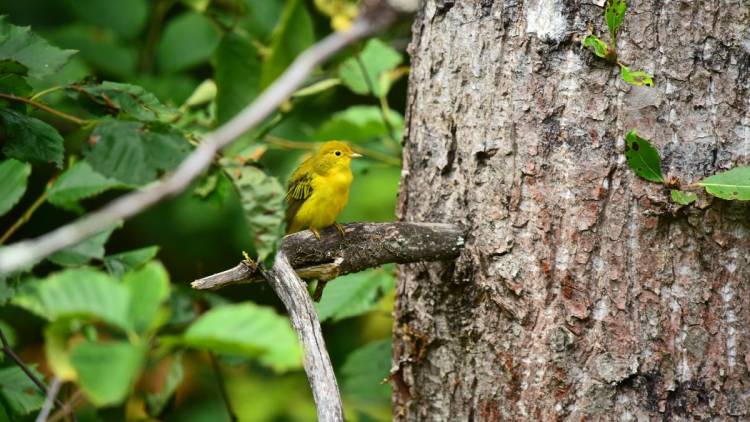
Orange-Crowned Warbler – Leiothlypis celata – grows between 4.8 to 5.3 inches tall and weighs 9 grams. They are yellowish-green in color with gray wing bars. The orange color after which this bird is named may not always be visible. They live in open areas with some shrubbery and feed on insects and berries.
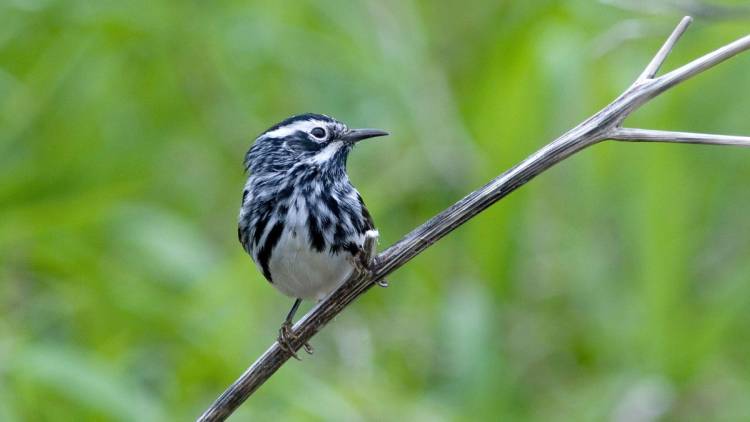
Black and White Warbler – Mniotilta varia – is devoid of any color except black and white, like an avian zebra, with eyebrows and black and white streaks on top of the head. They grow between 4.5 to 5.1 inches and weigh between 0.3-0.5 ounces. They live in deciduous and coniferous forests and search through tree barks for insects.
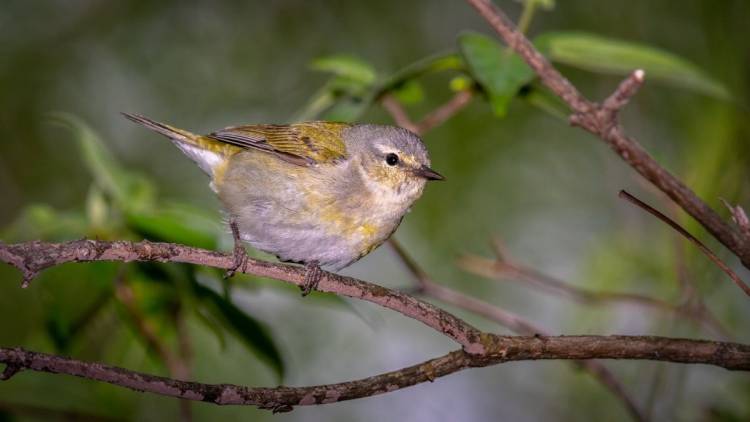
Tennessee Warbler – Leiothlypis peregrina – grows to 4.5 inches and weighs 0.3 ounces. The male has a white underbelly with gray wings and eyes, and a gray-yellow back. The female is yellow-green with a white underbelly and gray wings. Both males and females are nondescript without distinctive marks and can easily be confused with other birds. They spend time on the high branches of the forest and feed on insects. If they are on the ground, they will catch a caterpillar.
Herons in Indiana
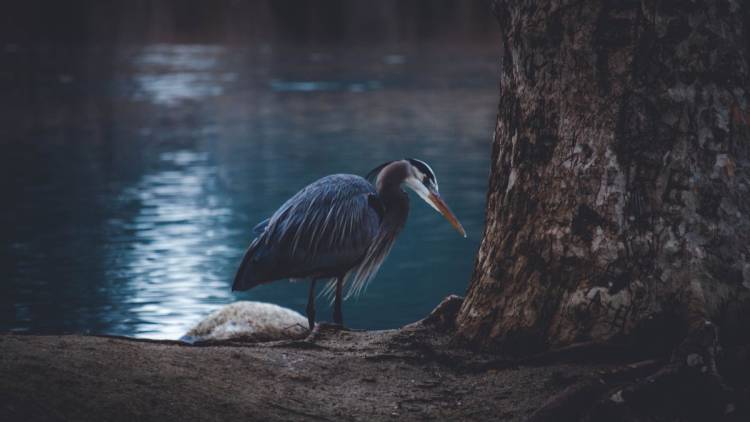
Great Blue Heron – Ardea Herodias – is tall with a very long neck that bends into an “S” when they are flying. They are grayish-blue with a black stripe over their eye. In Indiana, they can be found by lakes, rivers, and general wetlands. They wade through the water to hunt for fish, frogs, and small mammals. They grow between 38.2 and 53.9 inches, and weigh 74.1 to 88.2 ounces with a wingspan of 65.8 to 79.1
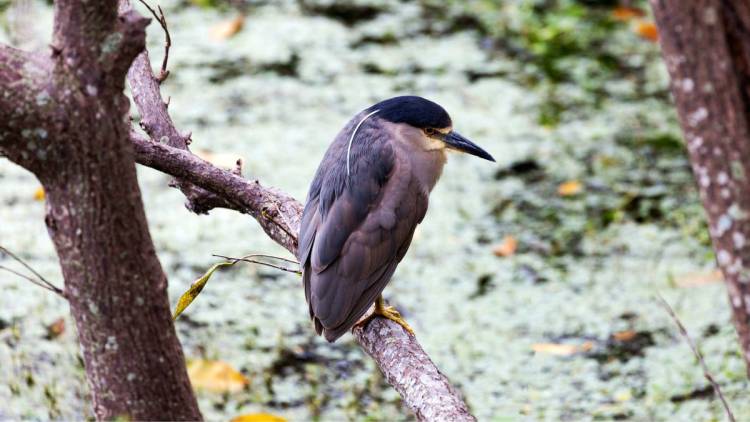
Black-crowned Night Heron – Nycticorax nycticorax – is small and stocky compared to some other herons. Instead of stretching its neck, it seems to tuck it in. They grow between 22.8 and 26.0 in length, and weigh between 25.6 and 35.8 ounces with a wingspan between 45.3 and 46.5 inches. In Indiana, they can be found near wetlands. They are out foraging during the evening to avoid sharing food with other herons while feeding on fish, frogs, clams, mussels, snakes, and crustaceans. They have a black head and back, with lighter-colored wings and a white underbelly.
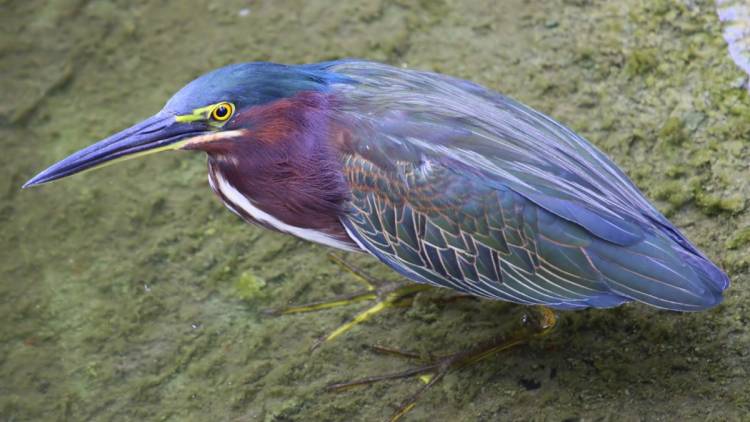
Green Heron – B. virescens – is short and stocky, with a gray-green head and a greenish cap and a brown neck. Their neck is usually tucked into their body. In Indiana, they live in wetlands where they remain unseen during the day, and feed on fish. They grow between 16.1 and 18.2 inches, weigh 8.5 ounces with a wingspan between 25.2 and 26.8 inches. Their back is a rich green, while their chest and neck are browner in color. They have dark gray wings.
Sandpipers
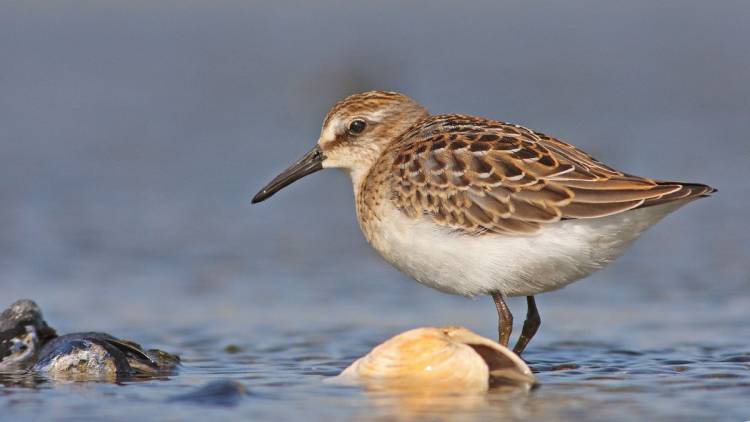
Least Sandpiper – Calidris minutilla – is the smallest of the sandpipers, barely larger than a sparrow. They haveround bodies and short wings, with brown upper bodies and white underbellies. Their yellow-green legs are thin and medium long. They grow between 5.1 and 5.9 in length, weigh between 0.7 and 1.1 ounces with a wingspan between 10.6 and 11.0 inches. The Least Sandpiper feeds on insects, spiders, and earthworms they find in the mud.
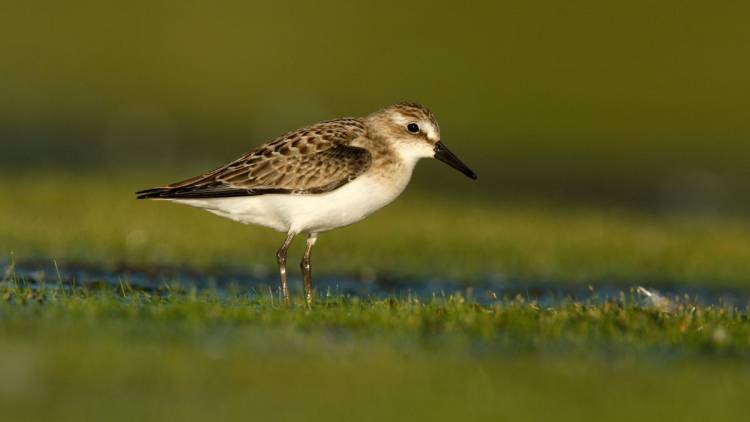
Semipalmated Sandpiper – Calidris pusilla – is short and plump, barely larger than the tiny Least Sandpiper. They grow between 5.9 and 7.1 inches in length, weigh between 0.6 and 1.8 ounces with a wingspan between 13.8 and 13.8 and 14.6. They are a dappled brown and black color on top and upper chest, with paler, almost white, underbellies. They live near the edges of lakes, mud and wetlands and used their thin, long bill to peck for small invertebrates.
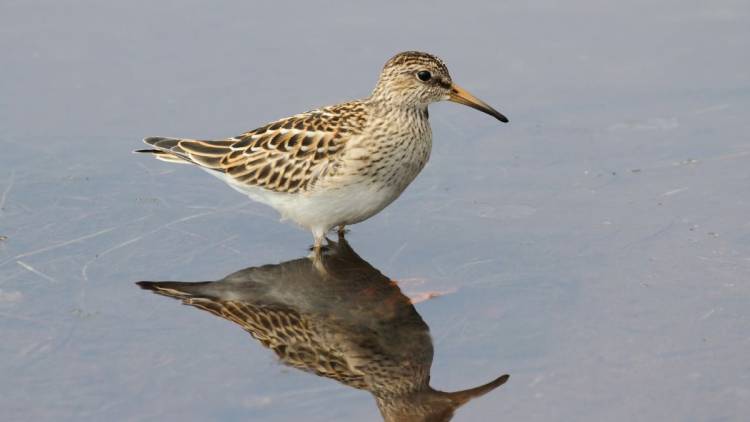
Pectoral Sandpiper – Calidris melanotos – is a medium-sized stout sandpiper, with the male 50 percent larger than the female. Their coloring is a speckled brown, gold, and black with a white underbelly and yellow legs. They peck around the mud of wetlands for invertebrates. They greatly resemble the Least Sandpiper but are twice as large.
Further Reading on Indiana Birding
For more information on birding in Indiana, consider the following guides:
- Parnell, Marc (Author)
- English (Publication Language)
These websites may also provide additional information:
Did we miss any common birds? Did you find the bird you’re looking for? Let us know in the comments section.


